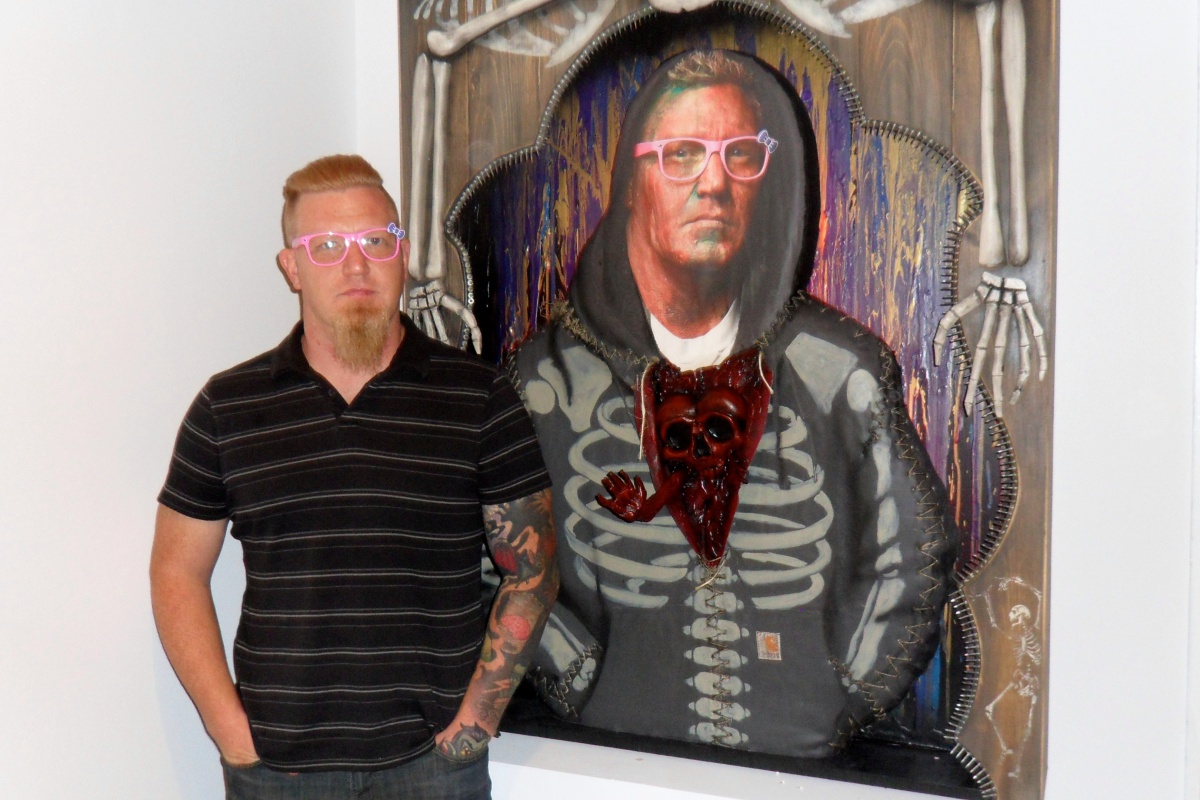Irrational Portrait Gallery Invites Appropriation

Photo credit: Brendan J. O’Reilly
In our post-post modern era, appropriation is invited. At least this is the case in the current exhibition at Southampton Arts Center, The Irrational Portrait Gallery—organized by photographer Rick Wenner and a group of 21 artists, members of the Long Island artist collective Fresh.
The project began with Wenner shooting portraits of each artist. He then gave the printed portraits back to the artists—at which point they were invited to re-work the image. With free reign to manipulate their portraits, each artist made the print their own—using media, style and technique distinctive to their own artistic practice. Despite the show’s title, there is rationality here. Artworks are similar in size, for the most part, and the guidelines of the project, while they grant freedom to manipulate, pose a structural undercurrent. It’s within a system, though, that individuality comes into focus.
The broadly expansive main gallery of the newly restored Southampton Arts Center provides the necessary ample space surrounding each portrait so that each unique work can be viewed and appreciated without distraction. Oliver Peterson, who works out of his studio in Water Mill, covered the background of his portrait with mixed-media collage cutouts for which he is known. The fragments give insight into Peterson’s world while Wenner’s photograph of the artist brings us one step closer to completing the puzzle. Colin Goldberg, the multi-media North Fork artist who works with a large-format printer, manipulated his image and reprinted it on canvas, with alternating layers of pigment and bare canvas making up his portrait. East End artist Steve Miller used inkjet and silkscreen on canvas—layering a reptilian skeleton x-ray image over his face. Works by Renee Michele Andolina, Anjipan, Katie Berka, Krista Biedenbach, Jon Duci, Robert Edwin, Peter Freleng, Peter Galasso, Carl Horn, Mike Krasowitz, Bryan Landsberg, Albert Lee, Ben Owens, Phetus, Michelle Posner, Matthew Satz, Stelios and Damon Tommolino—each strikingly personal—complete the exhibition.



Appropriation has its roots in the early 20th century—with Marcel Duchamp’s notorious “L.H.O.O.Q.” (1919), in which he drew a mustache on a postcard of the Mona Lisa, posing a philosophical debate on ownership and what it means to be an artist. In mid-20th century, Pop artists reproduced banal images from everyday life—using appropriation in a tongue-and-cheek questioning of art, amongst other things. Robert Rauschenberg’s “Erased de Kooning,” (1953) was done with de Kooning’s consent, as both a performance and collaboration with Jasper Johns (who did the lettering). In the case of “Pictures” generation Sherrie Levine’s “After Walker Evans” series, in which she re-photographed out of Evans’ exhibition catalogue, with no manipulation of the image, she was both criticized and exalted. Her series was rationalized as feminist critique and earned her a retrospective at the Whitney, but she was also sued by the Estate of Walker Evans. Roberta Smith’s New York Times review read, “But it is the clarity and passion of Evans’s images that hold us more than Ms. Levine’s subversive gesture.” (Nov. 11, 2011).
Rather than questioning authorship, the Irrational Portrait Gallery exhibition embraces co-creating. The lines between portrait and self-portrait are blurred, while a new light is shed on our understanding of photography and what it has become in today’s world. How we photographically present ourselves to the world and how we see ourselves versus how others see us and how we perceive how others see us is pertinent and relevant in a society glued to social media. Inviting appropriation is fresh take on photography and art—and kicks off the season at Southampton Arts Center with an exhibition that brings local artists together in a global conversation.
The Irrational Portrait Gallery is on view at the Southampton Arts Center, 25 Jobs Lane, Southampton, through July 20. For additional information, visit southamptonartscenter.org and irrationalportraits.com.




